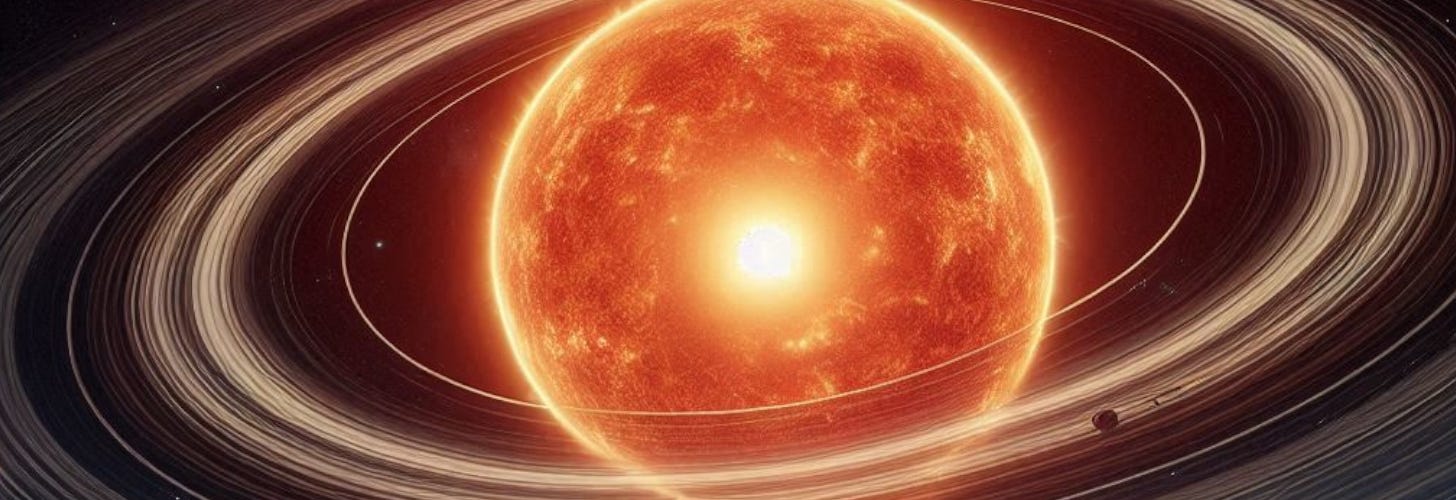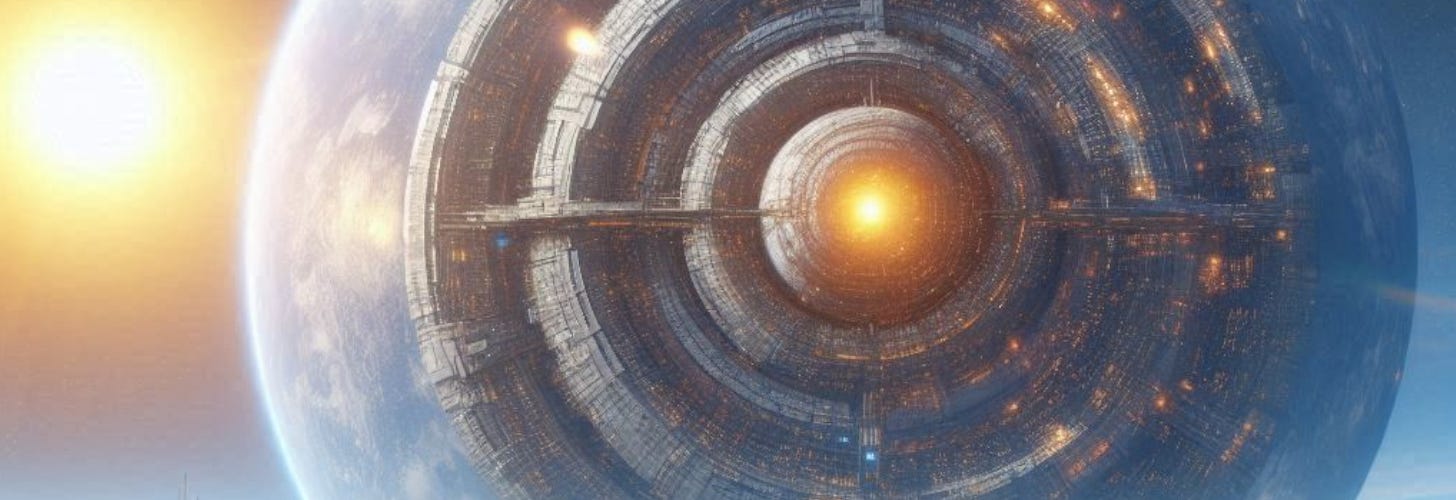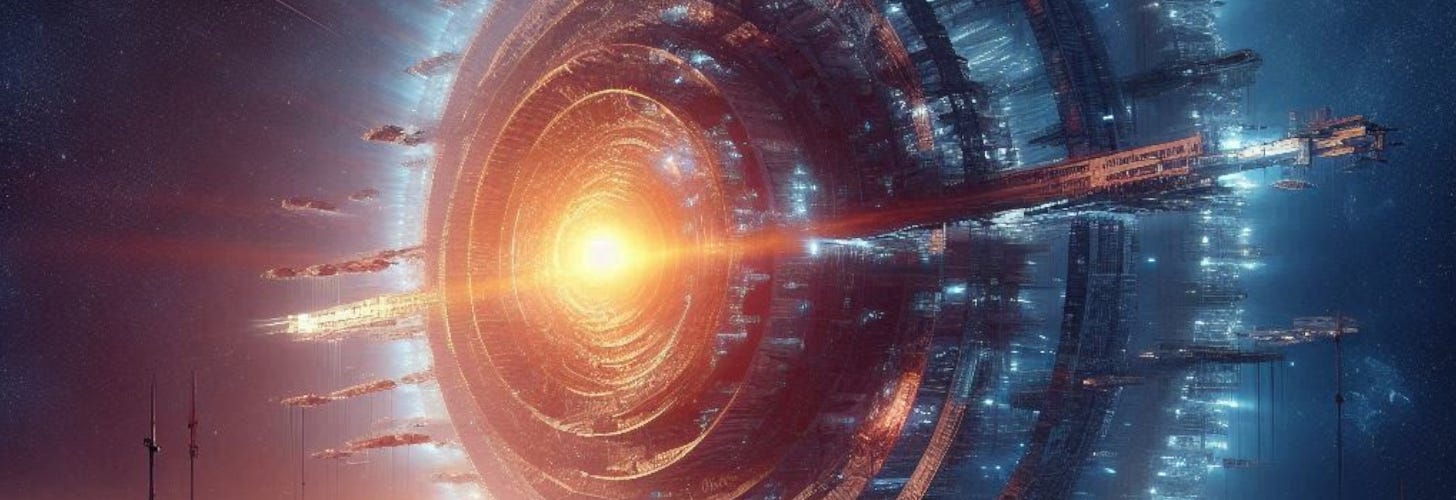Luminous star anomalies and megastructure theory
Where to find advanced civilizations in space?
Our current observation methods and universe knowledge occasionally confront us with spatial anomalies that spark sensational articles. For example, some may announce the probable discovery of extraterrestrial life. More often than not, new measurements confirm instead a natural phenomenon. However, a category of anomalies - the variable luminosities of certain stars - leaves both the public and the scientific community wondering whether extraterrestrial life is a real possibility. A new study by Shant Baghram (1), dated December 03, 2024, and to be published in the Astrophysical Journal (ApJ), suggests looking for Dyson Sphere-type structures near primordial black holes. The author also suggests adding a scale to that of Kardashev, to relate the advancement of a supposed extraterrestrial civilization to its spatial exploration distance.
How are exoplanets detected?
The first method involves measuring the relative velocity of objects using Doppler spectroscopic analysis. The aim here is to detect a change in a star's radial velocity, proving the gravitational influence that a massive object has on it. This change in radial velocity, induced by an exoplanet, creates something akin to a barycenter common to both objects. The barycenter is the shared center of mass between a star and its planets, the latter causing the star to oscillate slightly around this gravitational point. The Doppler-Fizeau effect causes shifts in wave frequency as a star’s distance relative to our detectors changes. Readers may already be familiar with the Doppler effect in sound waves, where the pitch of a car’s sound becomes higher as it moves closer and lower as it moves away. To visualize wave behavior, imagine shaking one end of a string. Near your hand, the waves appear short and frequent while farther away, they spread out and become longer.
Another method for detecting exoplanets is the observation of transits. For this to occur, the rotation plane of the targeted system must be aligned with the observer's line of sight. Thus, as the planet passes in front of its star, we can see an increasing drop in brightness as it approaches perfect alignment, where it will be positioned directly between us and the star, just like during an eclipse. This is known as planetary transit. This is where the first method, using radial velocities, comes in handy, as it doesn't depend on the orbital inclination axis, and allows us to detect the planets that do not obscure their star’s brightness.
We can differentiate an exoplanet from a megastructure not only because planets reflect the light of their stars, but also because they emit radiation of their own. However, this data is so faint that it cannot really be detected independently. Therefore, it is essential to first observe the stars and the data they transmit before detecting any planet orbiting around them. By analyzing the observed light spectra it becomes possible to deduce the nature of objects that have intercepted this light. This approach enables us to classify real observational “anomalies” and determine whether the occulting object is artificial or natural in origin.
Another technique rules out observations of poorly understood natural objects, and thereby concludes the presence of an artificial object. This involves checking if eclipses follow a regular sequence, suggesting artificial structures with consistent spacing.
For example, this could be explained by solar panels spaced at regular intervals. Let’s take a simple analogy: imagine a ball with needles stuck into it. Each needle is topped with a small sphere. These needles are evenly spaced, creating an unnatural arrangement. A planet would block the light for a period of several hours or days, at regular intervals. However, in the case of the star KIC 8462852, also known as Tabby's star, we observe irregular periods during which its light is obscured. Moreover, the dimming is far too significant to be caused by a giant planet. For instance, Jupiter blocks around 1% of our star's light, while KIC 8462852 experiences dimming between 15-22%, which is impossible even with a giant exoplanet.
What makes detecting these supposed structures so complex is that they must be aligned with our axis of observation. In other words, if the light is blocked in a direction opposite to our viewpoint, our current detection methods cannot observe any changes in brightness or infrared emission at a specific wavelength that would indicate energy absorption. We could only conclude the presence of a natural object, such as a planet, if this one is passing in our line of observation of the star.
There are two types of what scientists call “DS” for Dyson Sphere, meaning the presence of objects of various shapes designed to capture energy from their star. A complete DS is when the entire star is enclosed within an opaque structure, while a partial DS only obscures part of the star. For a partial DS, scientists look for moments of infrared radiation coinciding with a drop in the star's brightness, indicating that something is capturing the light. A complete DS would block all visible light from the star, leaving only heat to escape, which we would observe in infrared. Indeed, according to the laws of thermodynamics, energy must radiate as heat.
This highlights the challenge of interpreting observed wavelengths. It cannot be unequivocally attributed to the presence of a structure. In fact, many objects obscuring the visible light of a star - such as a cloud of hydrogen acting like cosmic dust, or a disk of debris or accretion signaling the early stages of planet formation - can produce the same visual effect of reduced starlight emission, as well as the creation of long-wavelength infrared. There is also the possibility of a quasar, in the background of the star, yielding similar observational results. Furthermore, an excess of infrared emission may also be caused by circumstellar dust heated by its star.
In the case of dust, we can detect its presence because infrared radiation struggles to penetrate through it, resulting in a degradation of the light signal. However, we can determine the original light emitted by the star by analyzing its spectrum, which allows for calculating the amount of dust between the star and our solar system. Circumstellar dust may obscure a system perfectly aligned behind it, even at a vast distance in another galaxy. This combined stream of light requires meticulous analysis to identify distinct signatures.
In summary, many factors could explain radiation patterns resembling those of hypothetical megastructures. The scientific community does not reject the potential existence of such structures, which could explain certain anomalies. However, these anomalies are likely to find natural explanations in the future, as has often been the case in the past. This is because the data requires spectroscopic analysis to study the light spectrum and detect, for example, signal degradations. Such analyses can help determine the true nature of the objects the light has passed through, as well as the original source of the light itself.
It's important to understand that we observe the universe on a broad scale. Hence, before investing time and money, the community must establish that an observation is sufficiently inexplicable to warrant further analysis. In other words, anomalies with potential natural explanations will only be studied in depth at a much later stage. Initially, we collect “raw” data to identify the presence of objects, before moving on to more complex measurements to determine their exact nature.
Dyson spheres
Dyson spheres were theorized by physicist Freeman Dyson in 1960, though he had envisioned the concept as early as 1945. It is a biosphere made of a hollow shell of artificial material, designed to capture a very large portion of the stellar radiation emitted by a star. Such a structure could power an advanced civilization, addressing resource depletion or surging energy demands from population growth. A Dyson Sphere could also centralize energy production, eliminating the need to transport resources across planets. This would be particularly beneficial in the periods when planets orbit on opposite sides of the star. Astronomer Nikolai Kardashev developed a scale to classify the advancement of extraterrestrial civilizations. A Type I civilization would be able to use all the energy available on its home planet, while a Type II civilization would be able to use all the energy output of its star. The Dyson sphere corresponds to this Type II level of advancement. Finally, this megastructure could also take various forms, including a shell, a bubble, a ring, or a swarm. Since it would block all or a significant part of its star’s light, infrared detection is required to identify such a sphere. This is because, according to the laws of thermodynamics, the energy must escape and radiate as heat
Several issues challenge the possibility of such an object’s existence. First, building an object larger than a star would require resources equal to or exceeding all those in the solar system. Second, this object would not adhere to certain physical laws, such as shear forces. Moreover, the physicist Maddox argues that a structure cannot reach an astronomical unit in radius. Another question is how a hollow mass of this size could resist the laws of physics without collapsing under its own gravitational forces. How would these forces interact with the star’s gravity? What would the common barycenter of this structure and the star be? Would there even be one? If so, what gravitational influence would this have on the other planets around it? Let us not forget that planets deprived of sufficient light would cool significantly. To sustain planets deprived of light, a significant portion of captured energy would be needed, leaving little net gain. This challenge is compounded by the energy costs of interplanetary transport unless the solar system is uninhabited and dismantled for materials. In such a case, the civilization using this structure would live outside this solar system. However, this again raises the issue of energy transport over greater distances. Unless this civilization has very rapid energy transport capabilities - which is plausible - it would still require significant energy.
Freeman Dyson clarified that he envisioned not a solid shell, but a swarm of independently orbiting collectors. It is therefore more accurate to describe it as a group of “collectors” orbiting around the star rather than a cohesive sphere. Nevertheless, the concept of a sphere has remained in the collective imagination, including in scientific language, even though its creator never conceived of such a structure.
In the likely case of a swarm, it too would obscure part - or a significant portion - of its star. Visible light would then be absorbed by this structure, or more precisely, this set of structures. If light were totally blocked by a Dyson sphere in the literal sense, we would detect a massive object pulling planets into orbit without observing any direct light. The star would still be detectable through infrared observation of the heat released. A swarm, on the other hand, would block light at likely regular intervals, indicating an unnatural spacing of the objects surrounding the star.
Giant solar panel
What seems most likely is the existence of one or more solar panels capturing the energy of a star, corresponding to the category of swarms imagined by Dyson, consisting of one or more giant objects. On the one hand, such a design is achievable without requiring an incredible amount of resources; on the other hand, it does not violate any physical principles. It could be detected via infrared. However, this also requires the structure to align along the axis between the star and the observing system. The observational result would be that of a star whose luminosity decreases as this structure passes through the observation axis. Imagine this panel orbiting its star. The star would be at its brightest when the panel is to the side or behind the star, and this luminosity would gradually decline as the object passes through the observation axis. When the panel aligns between its star and our solar system, we observe the star's lowest luminosity. It operates on the same principle as an eclipse.
Analysis of a candidate for the presence of a megastructure:
KIC 8462852, also known as Tabby’s star, is located in the constellation Cygnus and exhibits a luminosity drop ranging from 15% to 22%. This star has intrigued researchers, and many theories have been proposed to explain these observations:
A poorly formed star. This explanation is unlikely, as no circumstellar ring has been observed.
A field of planetary debris caused by the collision of two planets. This theory seems insufficient, as such debris would be heated by the star and emit infrared, which is not observed.
A planet falling towards its star and breaking apart. This would involve very large debris that is not heated by the star. This explanation differs from the one above and remains plausible.
A planet with oscillating rings. Further radial velocity measurements will confirm or disprove this hypothesis.
Cooling of the star's photosphere. Differential rotation, a phenomenon where a star’s layers move at different speeds, reduces the efficiency of heat transport. The missing heat flux creates a slight increase in internal energy.
A disintegrating cloud of comets. This explanation is challenged by the observed 22% luminosity drop, which appears too significant to result from such a cloud.
An irregular dust ring. According to some research, observed data aligns with this theory, especially since an object larger than a dust particle would block all wavelengths equally when passing in front of the star. However, infrared light exhibits fewer variations than ultraviolet light, raising further questions.
There remain a few theories, but none of these explanations fully match the collected data. The megastructure hypothesis also fails to explain the observed luminosity drop. Steve Howell likens KIC 8462852 to KIC 4510611, which also exhibits strange light variations. Subsequent research revealed that KIC 4510611 was, in fact, a quintuple system - a stellar system composed of five small stars orbiting one another.
Conclusion and thoughts on extraterrestrial intelligence:
There are other interesting stars like the ones mentioned above, where the possibility of extraterrestrial intelligence harnessing its star’s energy is among the solutions proposed by scientists. However, we must remain patient and open to the fact that, as we've seen, there are still many likely natural explanations. These explanations can often interconnect - for instance, a stellar system combined with the presence of planetary debris - making our observations appear very strange.
Some logical problems arise when questioning the usefulness of such structures. First, in theory, there is a solution that brings far greater results: sending energy into a black hole and recovering it with a higher yield, creating an infinite source. Without delving into this technique, we can see that even with our current knowledge, we are already theorizing more efficient methods, while we are still unable to conceive a megastructure to harness the energy of a star. So how much do we know about a civilization capable of hypothetically creating such an object? Would these intelligences still need to use this method, or have they found something better? It is logical to assume they might possess far more efficient energy methods. Could they even be able to create energy out of nothing - or almost nothing, given that total vacuum does not exist? However, what I find most interesting is that we, ourselves, are on the threshold of an extraordinary level of knowledge. Indeed, our current artificial intelligence is destined to become, in the future, an autonomous consciousness - an unimaginable research tool, given its capacity to progress exponentially. This would be a superintelligent AI able to self-improve and process data from everything around us. The need for data storage and computational power led us to create computers, which, in turn, gave us the idea to use them as autonomous tools.
In theory, it is highly possible that such a research device could exist if a civilization were to surpass the technological threshold we are currently striving to reach. With such a tool, it is highly likely that this form of life would have found many other means of energy acquisition, as the level of knowledge provided by their AI would be extraordinary.
It therefore seems somewhat more realistic to search, not for an energy-absorbing structure, but for something akin to a artificial star like the one in Star Wars, serving as a habitat and possibly extraordinarily massive. The term ‘’star’’ is the movie is confusing, it is obviously a planet. Such an object would exhibit the same characteristics as a megastructure, obstructing its star's light, while not emitting the same radiation as a planet. The advantage would be providing a living environment adapted to various needs or desires, without having to modify an existing planet. Perhaps this might also stem from a form of life that respects other life forms already existing in the system in which they have implanted their artificial planet. In this scenario, both species would coexist in harmony, without one colonizing the other or encroaching on pre-existing living spaces. Another possibility is that they destroy all planets of a system while they use this dark star as a base on the middle of the system. Alternatively, this might not be a life form at all, but a super AI that has taken over or replaced the people who created it. We are already experiencing “alignment” challenges with our AI systems - the divergence between the methods requested to achieve a result and the means the AI uses to accomplish it. Such a tool could therefore degenerate seriously if poorly designed or insufficiently monitored.
(1) In Search of Extraterrestrial Artificial Intelligence through the Dyson Sphere-like structures around the Primordial Black Holes, Chant Baghram, 03_12_2024, Cornell University. https://arxiv.org/abs/2412.02671 .








